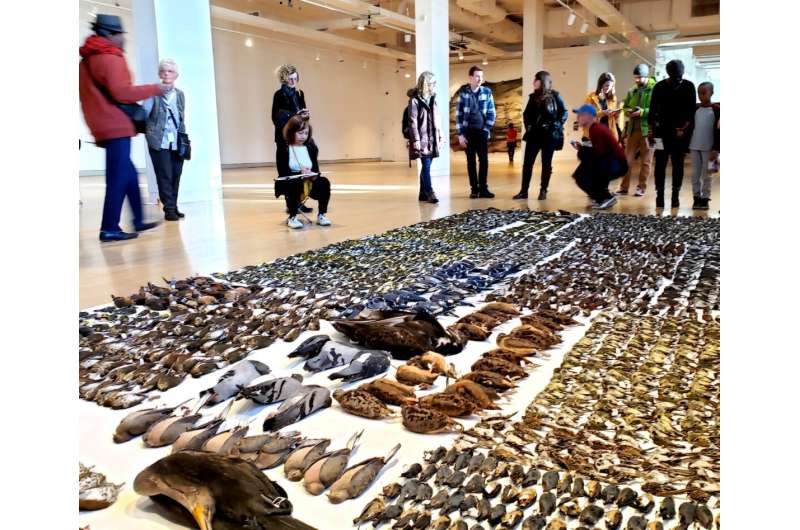This article has been reviewed according to Science X's editorial process and policies. Editors have highlighted the following attributes while ensuring the content's credibility:
fact-checked
peer-reviewed publication
trusted source
proofread
Grassroots data is vital for reducing deadly bird-window strikes, says study

Much of the progress made in understanding the scope of bird deaths from building and window collisions has come as the result of citizen science, according to a newly published study. But the study also concludes that such grassroots efforts need more buy-in from government and industry, and better funding so they can keep a foot on the gas in their efforts to reduce bird-window collisions.
These conclusions stem from research by authors at 22 universities, non-governmental organizations, government agencies, and conservation organizations. Their study is published in the journal Frontiers in Ecology and the Environment. As examples, the study highlights the Lights Out Texas program in the United States, the China Anti-Bird Window Collision Action Alliance, and the Fatal Light Awareness Program (FLAP) in Canada. FLAP Canada has been at the forefront of this issue for 25 years and is the template for many of the newer collision prevention efforts.
"During the last 5 to 10 years there's been a groundswell of public, conservation, and scientific attention to bird-window collisions," said lead author Scott Loss at Oklahoma State University. "Citizen scientists are leading the way, growing awareness of this major threat to birds, and advocating for bird-friendly buildings and policies. There's tremendous potential for these projects to do more but they need support, and more conservation organizations need to make collision reduction a key part of their objectives. Conservation funding is always a challenge and perhaps especially so with this often-overlooked global issue."
Loss led the 2014 study that estimated anywhere from 365 million to nearly one billion birds are killed by window collisions each year in the U.S. alone. He says more than half the data he relied upon for that study came from citizen-science projects around North America.

The three programs highlighted in the new study share an important strategy: multiple diverse partnerships. These projects also inspire local action by focusing on unique regional conditions and familiar birds. But there are some big hurdles to clear before significant progress can be made on a broader scale.
"Right now, collection of bird-window collision data is often piecemeal with insufficient sampling at too few locations and times," said senior author Andrew Farnsworth at the Cornell Lab of Ornithology. "Through the Lights Out Texas project, we're developing a formula that we hope can be applied anywhere to guide data collection and inspire local action. And we need much more data, especially from countries outside the U.S. and Canada."
Researchers and students at Duke Kunshan University in China began bird-window collision surveys in 2018, which led to formation of the China Anti-Bird Window Collision Action Alliance in 2022. The Alliance is running a long-term survey to answer basic questions about the scope of the bird collision problem in China and to find to evidence-based solutions.

"Students and young people are definitely the driving force behind China's collision prevention efforts," said co-author Binbin Li, an assistant professor at Duke Kunshan University. "Our university is leading the national survey effort and the majority of those on our team are undergraduate students. They draft social media posts to recruit volunteers, prepare training materials, design survey forms, and much more. There's been an increase in awareness of the problem, but there's still a lot of work to do."
"These grassroots programs are collecting data meant to inspire action," Scott Loss said. "The goal is to make communities more bird-friendly through science, education, and advocacy campaigns."
"Finding birds killed by window collisions is, unfortunately, a global, shared experience," Farnsworth adds. "We have a huge opportunity to do better now that we're so interconnected. We still know precious little about where, when, and how birds are dying. But we can move the needle on reducing collisions worldwide with important–and essential–contributions from citizen science."
More information: Scott R Loss et al, Citizen science to address the global issue of bird–window collisions, Frontiers in Ecology and the Environment (2023). DOI: 10.1002/fee.2614
Journal information: Frontiers in Ecology and the Environment
Provided by Cornell University


















